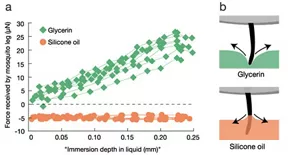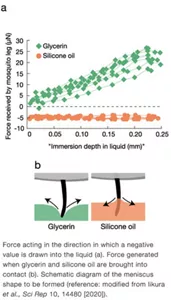Repellent Research Focusing on Mosquito Blood-sucking Behavior
On What Type of Surface Can Mosquitoes not Land?
The experimental results on the relationship between legs and wettability, which affects the landing behavior of mosquitoes, are introduced.
Relationship between mosquito legs and wettability
What effect does the wettability relationship between mosquito legs and liquids have on mosquito landing behavior? In the case of glycerin, which has low wettability on mosquito’s legs, the force when the legs come into contact with the liquid is zero, and the more you push it, the more repulsive is the generated force. However, in low-viscosity silicone oil, a strong attractive force (meniscus force) is immediately generated by the contact between the leg and the liquid (Fig.). That is, the mosquitoes that have settled on the surface of the silicone oil coating film have a strong attraction to the coating film through their legs. For example, if a total of four front and middle legs are accreted, and if the measured attractive force is applied to all four, the total value will be 4.96 μN. This is 87% of the gravity that mosquitoes produce, and this meniscus force is a non-negligible attraction for mosquitoes.
Figure: Force generated when a mosquito’s leg comes into contact with liquid.



Force acting in the direction in which a negative value is drawn into the liquid (a). Force generated when glycerin and silicone oil are brought into contact (b). Schematic diagram of the meniscus shape to be formed (reference: modified from Iikura et al., Sci Rep 10, 14480 [2020]).
- Home
- Innovation
- Research & Development
- Infectious Disease Control Study Dengue Virus Mosquito Research
- Repellent Research Focusing on Mosquito Blood-sucking Behavior
- On What Type of Surface Can Mosquitoes not Land?
- Home
- Innovation
- Research & Development
- Infectious Disease Control Study Dengue Virus Mosquito Research
- Repellent Research Focusing on Mosquito Blood-sucking Behavior
- On What Type of Surface Can Mosquitoes not Land?
